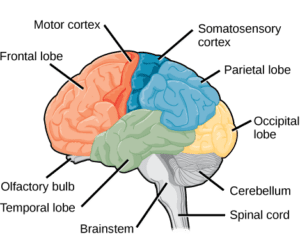Awake craniotomy is a surgical procedure in which a patient remains awake and alert during the surgery in order to monitor motor function.

Awake craniotomy involves the removal of a part of the skull to access the brain while the patient is awake. (Creative Commons)
Vijaya, a 30-year-old homemaker from the Suryapet district of Telangana, visited Kamineni Hospitals in Hyderabad with a sudden onset of seizures — unsure of what was happening to her. Her symptoms included seizures with temporary loss of awareness and unconscious, along with the stiffening of muscles.
The doctors at Kamineni Hospitals subsequently diagnosed her with a large lesion in the left motor cortex of her brain.

Parts of the brain. (Wikimedia Commons)
Imagine your brain as a control centre for your body. It helps you move your arms, legs, and do many other functions. Sometimes, there can be a problem in an area of the brain called the left motor cortex that affects the functioning of the body. In Vijaya’s case, there was a big swelling (lesion) in that area of the brain, which was the cause of her seizures (bouts of fits).
To gain a comprehensive understanding of the lesion and its relation to motor tracts, the doctors utilised a 3-Tesla MRI scanner — a special machine that takes pictures of the inside of the body, especially the brain, to help doctors see what’s going on.
The doctors also used functional MRI in Vijaya’s case to find which motor cortex of her brain was being affected. They discovered that the left motor cortex was close to the lesion they found earlier through the MRI scan.
In order to alleviate Vijaya’s symptoms, the doctors had to remove the lesion in order to prevent further seizure episodes. However, there was a catch!
Being close to a motor cortex, operating on the lesion while the patient is sedated could result in potential harm to the patient’s motor function. And, in such a situation, the only way to know if the motor functions are intact would be to wait till the patient regains consciousness.
To counter this problem, the doctors decided to perform an awake craniotomy — a surgical procedure in which a patient remains awake and alert during brain surgery.
Awake craniotomy involves the removal of a part of the skull to access the brain while the patient is awake. The purpose of keeping the patient awake during the craniotomy is to monitor their brain function in real-time.
By interacting with the patient during the procedure, the surgical team can map and protect important areas of the brain, such as those responsible for movement, speech, or vision. This helps minimise the risk of damage to these critical functions.
“Due to the proximity of the lesion to the motor area and considering the potential risks, the doctors opted for an awake craniotomy. This surgical technique, despite its high risk, allows real-time assessment of motor functions. The patient’s family was informed about the risks and benefits and, after careful evaluation, the decision was made to proceed with the awake craniotomy and remove the lesion,” the hospital informed South First.
The patient’s family was apprised of the potential risks associated with the surgery. “These risks include potential seizures during the procedure, promptly controlled by the skilled medical and anaesthesiology team using appropriate medications. Immediate ventilatory support may be necessary for patient safety and proper oxygenation. Transient limb weakness is also possible after surgery, but it typically improves over time during patient recovery,” the hospital said and added that the surgical team takes necessary precautions to ensure the best outcome for the patient.
Walking us through Vijaya’s procedure, Dr S Ramesh, Senior Neurosurgeon at Kamineni Hospitals, said, “During the procedure, the patient experienced seizures. However, with the support of our skilled surgeons and anaesthetist team, we were able to promptly control them using seizure medications and ice cold saline. Additionally, the utilisation of intraoperative high-resolution ultrasound allowed us to identify abnormal brain parenchyma — an area of the brain that is not functioning or appearing normal — enabling successful excision of the lesion. The patient experienced transient weakness following the surgery, which progressively improved over time.”
The awake craniotomy procedure lasted for approximately 4 hours. The patient’s recovery was relatively fast, the patient was able to fully recover within 3 days. Subsequently, the patient was discharged on the 7th day after the surgery.

May 18, 2024

May 18, 2024

May 18, 2024

May 18, 2024

May 18, 2024

May 18, 2024